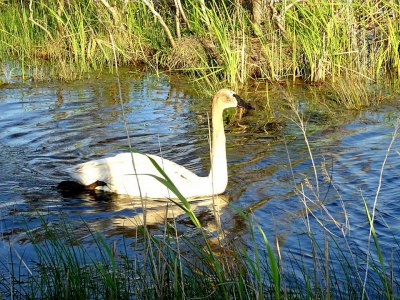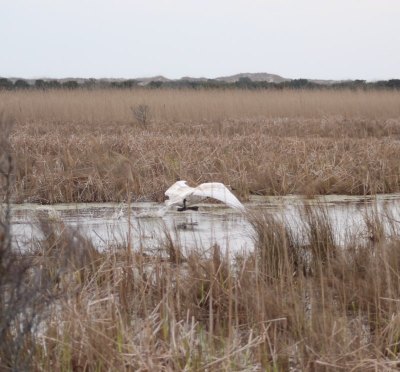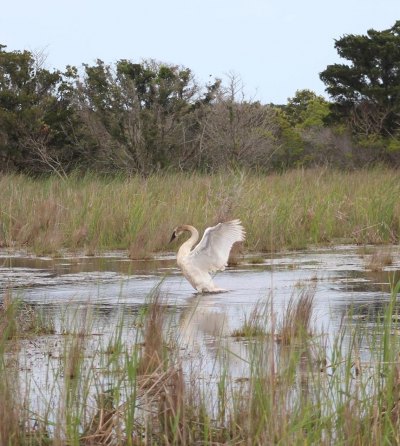The Lonely Swan
I don’t always have music by Russian composer Tchaikovsky stuck in my head, but when I do it’s Christmas (referencing The Nutcracker Suite here) or recently it’s been while walking on Ramp 72. Thanks to the Trumpeter Swan that’s stationed itself in the salt marsh around the ORV road, Swan Lake [specifically “No. 14 Scene finale-Swan theme (Moderato)” for all you music folks out there] resonates in my brain, though the swan itself doesn’t sound quite like a world-class trumpeter.
The Trumpeter Swan’s scientific name, Cygnus Buccinare, explains its name perfectly. Cygnus is “swan” and Buccinare means “to trumpet” in Latin. Just like humans, Trumpeter Swans have a buccinator muscle. And just like humans, that muscle is located in its cheeks. In humans this muscle allows us to blow out candles and play trumpets, for example. These swans use the muscle the very same way, though I doubt we will see one blowing out candles anytime soon.
Trumpeter Swans are the biggest waterfowl native to North America. With a body length of 54-62 inches and weighing anywhere between 17 and 28 pounds these birds are hard to miss! Their large bodies are completely white and they have a black bill and short black legs (not ideal for walking), so they spend a lot of their time wading or floating in shallow bodies of water. Even though they are heavy birds, they are very powerful. Running on top of the water to gain speed, they need at least a 100-meter “runway” in order to take flight. Once they start flapping those wings you’ll quickly notice their impressive wingspan which can reach close to 80 inches!

Unlike other birds, Trumpeter Swans do not sit on their eggs to incubate them. Instead, they cover their eggs with their webbed feet to keep the heat in! They tend to breed on wetlands from the Great Lakes to the Pacific Northwest and into Canada and Alaska, and hunker down for winter on ice-free coastal and inland waters. No matter where the birds are, they feed on aquatic vegetation and/or leftover crops and grains.
As youngsters, Trumpeter Swans pair up and stay with their partner through migrations. It is believed they mostly mate for life, but some swans have been found to have switched partners. It’s also been noticed that some males who lose their partner do not mate again. Maybe our swan is one of those males.
A swan is a rare sight on Ocracoke, and this one has made his home on Ocracoke for a month now. He happily obliges photographers with great shots.

To hear the Trumpeter Swan being trumpet-y, click here.
To watch video of Trumpeter Swans doing their thing, click here.




